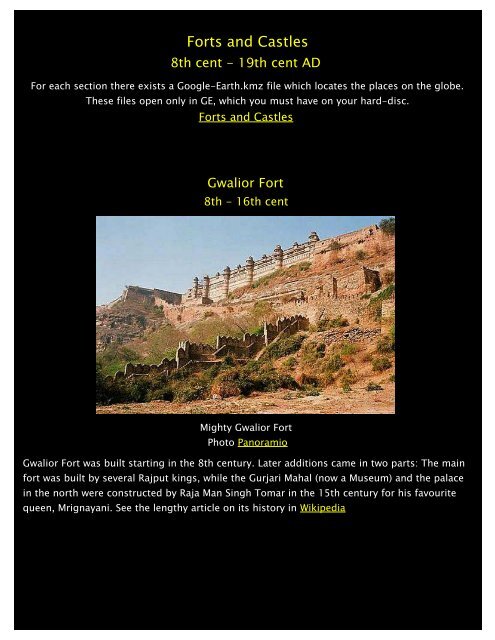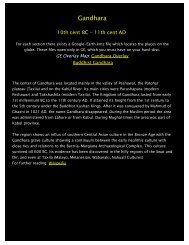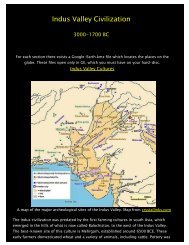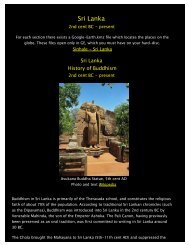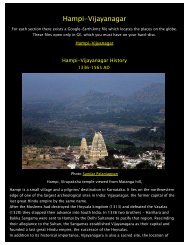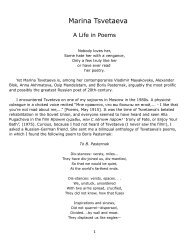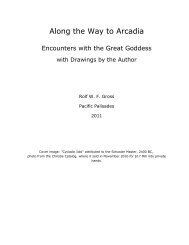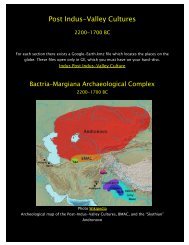Forts and Castles - Rolf Gross
Forts and Castles - Rolf Gross
Forts and Castles - Rolf Gross
Create successful ePaper yourself
Turn your PDF publications into a flip-book with our unique Google optimized e-Paper software.
<strong>Forts</strong> <strong>and</strong> <strong>Castles</strong><br />
8th cent - 19th cent AD<br />
For each section there exists a Google-Earth.kmz file which locates the places on the globe.<br />
These files open only in GE, which you must have on your hard-disc.<br />
<strong>Forts</strong> <strong>and</strong> <strong>Castles</strong><br />
Gwalior Fort<br />
8th - 16th cent<br />
Mighty Gwalior Fort<br />
Photo Panoramio<br />
Gwalior Fort was built starting in the 8th century. Later additions came in two parts: The main<br />
fort was built by several Rajput kings, while the Gurjari Mahal (now a Museum) <strong>and</strong> the palace<br />
in the north were constructed by Raja Man Singh Tomar in the 15th century for his favourite<br />
queen, Mrignayani. See the lengthy article on its history in Wikipedia
The Entrance Gate.<br />
Notice the characteristic tile ornaments installed by the 16th cent Moslem rulers.<br />
Photo Panoramio<br />
Ch<strong>and</strong>eri Fort<br />
10th - 15th cent<br />
Badal Mahal Gate (1450) <strong>and</strong> the Fort Kirti Durg (11th cent)<br />
Photo ch<strong>and</strong>eri.net
Kh<strong>and</strong>agiri Jain Temple <strong>and</strong> pilgrimage site, Giant Rishabhnath statue in cave 6 (1236)<br />
Rock paintings near Ch<strong>and</strong>eri, prehistoric<br />
Photos ch<strong>and</strong>eri.net
Tirupati, Ch<strong>and</strong>ragiri Raja Mahal<br />
11th cent - 1367<br />
Photo Panoramio<br />
Ch<strong>and</strong>ragiri is famous for the historical fort, built in the 11th century, <strong>and</strong> the Raja Mahal<br />
(King's Palace) within it. Ch<strong>and</strong>ragiri was under the rule of Yadavrayas for about three centuries<br />
<strong>and</strong> came into control of Vijayanagar rulers in 1367.<br />
Ch<strong>and</strong>ragiri was the 4th capital of Vijayanagar Empire, Rayas shifted their capital to here when<br />
Golconda sultans attacked Penukonda. In 1646 the fort was annexed to the Golkonda territory<br />
<strong>and</strong> subsequently came under Mysore rule. It went into oblivion from 1792 onward.<br />
Photo Panoramio , Text Wikipedia
Jaipur<br />
Palace of the Winds<br />
1156-17th cent<br />
View of town from the western ridge.<br />
Photo Panoramio<br />
In 1156 Rawal Jaisal, the sixth in succession from Deoraj, founded the fort <strong>and</strong> city of<br />
Jaisalmer, <strong>and</strong> made it his capital as he moved from his former capital at Lodhruva (which is<br />
situated about 15 km to the south-east of Jaisalmer). In 1294, the Bhatis so enraged the<br />
emperor Ala-ud-din Khilji that his army captured <strong>and</strong> sacked the fort <strong>and</strong> city of Jaisalmer, so<br />
that for some time it was quite deserted. After this there is nothing to record till the time of<br />
Rawal Sahal Singh, whose reign marks an epoch in Bhati history in that he acknowledged the<br />
supremacy of the Mughal emperor Shah Jahan.
Hawa Mahal (the Palace of Winds.)<br />
Photo palaces<strong>and</strong>tigers.com<br />
Amber Fort<br />
16th cent<br />
Amber Fort from the valley<br />
Photo Panoramio
Amber was originally built by the Meenas in the town they consecrated to Amba, the Mother<br />
Goddess, whom they knew as `Gatta Rani' or `Queen of the Pass'. Built over the remnants of<br />
an earlier structure, the palace complex which st<strong>and</strong>s today was commenced under the reign<br />
of Raja Man Singh, Comm<strong>and</strong>er in Chief of Akbar’s army <strong>and</strong> a member of the Emperor's inner<br />
circle of nine courtiers, in 1592. The initial structure of the fort was entirely completed by his<br />
descendant, Jai Singh I. Amber was modified by successive rulers over the next 150 years, until<br />
the Kachwahas shifted their capital to Jaipur during the time of Sawai Jai Singh II.<br />
Jaisalmer<br />
12th - 17th cent<br />
The Fort of Jaisalmer.<br />
Photo Panoramio<br />
In 1156 Rawal Jaisal, the sixth in succession from Deoraj, founded the fort <strong>and</strong> city of<br />
Jaisalmer, <strong>and</strong> made it his capital as he moved from his former capital at Lodhruva (which is<br />
situated about 15 km to the south-east of Jaisalmer). In 1294, the Bhatis so enraged the<br />
emperor Ala-ud-din Khilji that his army captured <strong>and</strong> sacked the fort <strong>and</strong> city of Jaisalmer, so<br />
that for some time it was quite deserted. After this there is nothing to record till the time of<br />
Rawal Sahal Singh, whose reign marks an epoch in Bhati history in that he acknowledged the<br />
supremacy of the Mughal emperor Shah Jahan.
Jodhpur<br />
Meherangarh Fort<br />
15th - 17th cent<br />
Photo dpsahoo.com<br />
Jodhpur's main attraction is the Meherangarh Fort (16th cent)<br />
Jodhpur was founded in 1459 by Rao Jodha, a Rajput chief of the Rathore clan. Rao Jodha<br />
succeeded in conquering the surrounding territory <strong>and</strong> thus founded a state which came to be<br />
known as Marwar.<br />
Bundi, Taragarh Fort<br />
1345 - 17th cent<br />
Bundi Palace <strong>and</strong> Fort
The Taragarh Fort, or 'Star Fort' is the most impressive of the city's structures. It was<br />
constructed in 1354 AD on a steep hillside. The largest of its battlements is the 16th century<br />
bastion known as the Bhim Burj<br />
Pink sari in the old fort.<br />
Photos Fern<strong>and</strong>o M, travelblog.org<br />
Agra, the Red Fort<br />
1565 - 17th cent<br />
Red Fort in the Jamuna river fog.<br />
Photo Panoramio
The most important fort built during the Mughal era is Agra Fort constructed by Akbar<br />
between 1565 <strong>and</strong> 1573. Akbar erected the walls, gates <strong>and</strong> the first buildings within the<br />
walls. Shahjahan built the imperial quarters <strong>and</strong> the mosque. A century later, Aurangzeb<br />
finished the outer walls of the fort.<br />
Moti Masjid,<br />
Photo Panoramio<br />
Within the fort, Moti Masjid is one large <strong>and</strong> two smaller mosques. The larger mosque, Moti<br />
Masjid made of marble, is the crown of Mughal architecture. It is a tragedy that it has been<br />
closed to the public in recent years.<br />
View of the Taj Mahal from the Red Fort<br />
Photo Panoramio
Gohad Fort, Madhya Pradesh<br />
!7th - 19th cent<br />
Photo Panoramio<br />
The history of Gohad is closely related to Gwalior. Its fort served as stronghold for a long<br />
number of Jat ranas <strong>and</strong> rajas. It is now mostly in ruins


